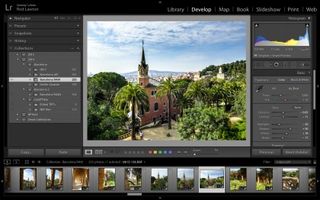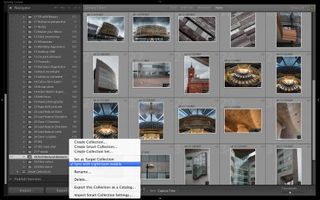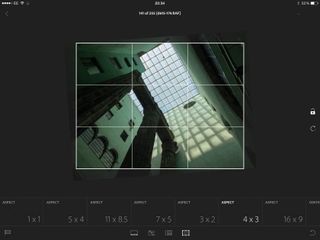TechRadar Verdict
Lightroom Mobile is like an interesting and important step forward into 'cloud' photography, but it offers only a portion of your full Lightroom library and a subset of your regular editing tools.
Pros
- +
Easy image browsing
- +
Simple controls
- +
Shared Collections visible online
Cons
- -
Limited selection of tools
- -
Image access restricted to shared Collections
- -
No Android support
Why you can trust TechRadar
Adobe Photoshop Lightroom is designed for enthusiasts, experts and professional photographers who need powerful image cataloguing tools, not just an image-editor. Photoshop can get the most out individual images, but Lightroom can import, organise and enhance them in bulk.
It's a powerful image database that can easily search, sort and display tens or hundreds of thousands of images stored on an internal or external drive, in multiple locations.
Lightroom also offers fully non-destructive editing. Your original images are never altered in any way, and the adjustments you apply in Lightroom are saved alongside the images and can be altered or removed at any time.
These editing tools are based on Adobe Camera Raw, the raw conversion tool that comes with Adobe Photoshop. You can apply a wide range of tonal and colour adjustments, image effects like vignetting and grain, and localised adjustments including graduated and radial filter effects and manual 'brushed' adjustments. It even has a quick and powerful cloning/repair tool.

Lightroom isn't designed to replace Photoshop, though its editing tools are powerful enough to mean you need Photoshop, or other image-editing software, less and less often. You can also use Lightroom and other software in tandem – edited images are saved back into the Lightroom library alongside your originals.
The latest update to Lightroom, Lightroom 5.4, introduces a brand new online synchronisation tool – Lightroom Mobile. This enables you to use Adobe's new Lightroom mobile app to view images from your desktop Lightroom library on your iOS device (there's no Android version yet), make adjustments, tag images with 'flags' and synchronise changes back to your desktop computer.
Sync photos with your iOS device
This is really easy to do – once you've linked Lightroom to your Creative Cloud account, you simply mark the Collections that you want to synchronise. That is as far as it goes though. You can't sync your entire image catalog, Smart Collections, nor the folders containing your original images.
This system will work well enough for photographers who use Lightroom's Collections (albums, in other words) as their primary organising tool, but not everyone does.

For Mac owners, Lightroom's chief rival is Aperture, Apple's own professional image cataloguing tool. This can already sync your whole library with your iOS device (via iTunes) or any portion of it, though it doesn't offer Lightroom Mobile's editing tools.
Lightroom Mobile doesn't copy across your full-resolution files because these would be too large. Instead, it uses 'Smart Previews' which are resized and highly compressed versions of the originals – but they still have more than enough resolution to display perfectly well on a tablet, and they can still store the adjustments you make and then synchronise them back to your desktop machine.
Nevertheless, this process takes time. In our test, 300 images took an average of 30 seconds each to transfer over a regular domestic broadband connection. The transfer times are manageable, but you may need to plan them into your schedule.
Online galleries
Lightroom Mobile is designed primarily for synchronising images between devices, but there is a bonus – you can also view your mobile Collections online at lightroom.adobe.com. You click a Collection tile to see all the images, and view them individually or as a slideshow. You can keep your Collections private, or share them with other people. The same system is used on your iOS device.

iPad viewing and editing
The Lightroom Mobile app is free and, once you've signed in to your Creative Cloud account, it synchronises automatically with the Collections you've shared in the desktop version.
It works in the same way as the web galleries – you tap on a Collection to see its contents and you can tap an image to see individual images.
The difference here is that Lightroom Mobile can also edit your images – though there are limitations. You're restricted to the tools in Lightroom's Basic panel, which are fine for everyday enhancements and adjustments, but not for more advanced work. You can't apply lens corrections, for example, or localised adjustment brushes.

You can apply Lightroom's built-in preset image effects, but you can't create your own on the iPad or, it seems, access any custom presets you've created in the desktop version. You can flag images as 'Rejects', 'Unflagged' or 'Picks', but you can't as yet add ratings, keywords or other image metadata.
Any changes you make are synchronised back to the desktop version, but if you launch the app when you don't have a wi-fi connection and if you don't have a cellular-enabled device, this synchronisation will be postponed until you do have a connection.
In your regular home or office environments the connection might not be a problem, but out in the field it could prove easy to forget the need for a live connection, and to lose track of what's synchronised and what isn't yet.
New features in Lightroom 5.4
Lightroom Mobile is by far the most significant update for Lightroom 5.4, though Lightroom has been updated to include raw compatibility with a number of important new cameras, including the Canon EOS 1200D, Fujifilm XT-1 and Nikon D4S. Fujifilm fans should also note that this release includes support for Fujifilm colour profiles such as Provia/Standard and Velvia/Vivid for the company's high-end compacts and compact system cameras. The full list of new cameras supported is here.
Otherwise, Lightroom 5.4 simply offers a selection of bug fixes and minor control enhancements. Lightroom Mobile aside, this is essentially a maintenance release.
Verdict
Lightroom has evolved into a very powerful editing tool, though the cataloguing and organising functions have changed relatively little, and this is where Lightroom can feel clunky and ill thought-out. It separates Folders and Collections completely, forcing you into choosing one or the other as a primary organising system or an awkward combination of both. And its stacking system for grouping related files together is local to individual Collections – you can stack images in one place, but they're not stacked elsewhere. It makes it difficult to keep track of different versions of the same image.
We liked
The powerful cataloguing and non-destructive image-editing tools, integration with external editors and the neat if basic Mobile version.
We disliked
Mobile tools are not powerful enough and it lacks Android support. Lightroom's Folder, Collection and stacking system could be improved, too.
Final verdict
Lightroom Mobile is like an interesting and important step forward into 'cloud' photography, but although the first version works brilliantly straight out of the box, it offers only a portion of your full Lightroom library and a subset of your regular editing tools.

